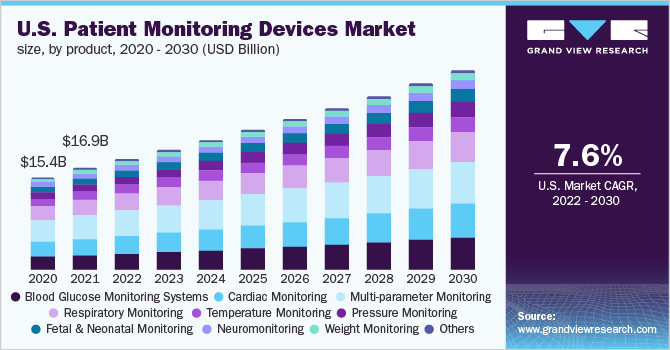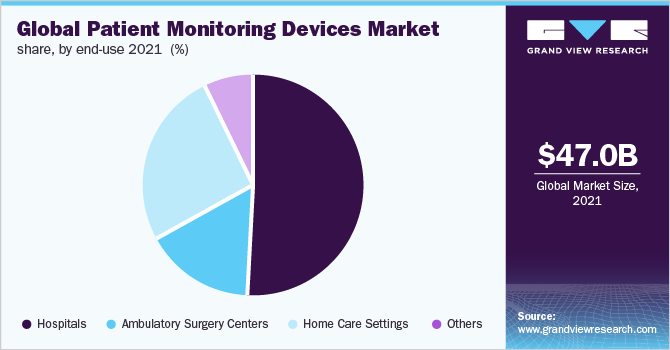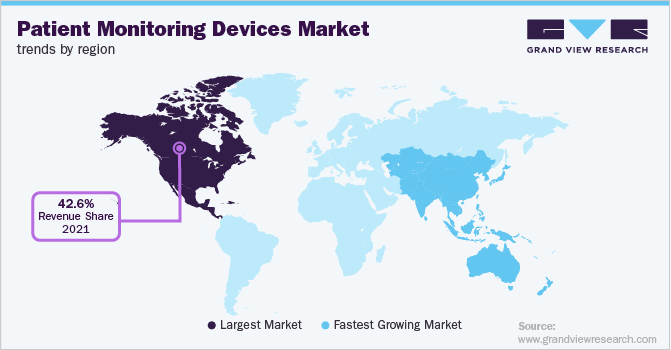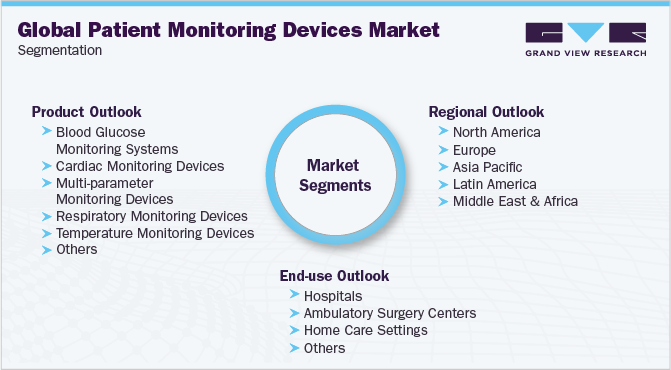- Home
- »
- Medical Devices
- »
-
Patient Monitoring Devices Market Size, Industry Report 2030GVR Report cover
![Patient Monitoring Devices Market Size, Share & Trend Report]()
Patient Monitoring Devices Market Size, Share & Trend Analysis Report By Product, By End-Use (Hospitals, Ambulatory Surgery Centers, Home Care Settings, Other End Users), By Region, And Segment Forecasts, 2023 - 2030
- Report ID: GVR-4-68039-444-2
- Number of Report Pages: 187
- Format: PDF, Horizon Databook
- Historical Range: 2018 - 2021
- Forecast Period: 2023 - 2030
- Industry: Healthcare
Report Overview
The global patient monitoring devices market size was valued at USD 51.1 billion in 2022 and is expected to expand at a CAGR of 7.7% from 2023 to 2030. The expansion of the industry can be attributed to the rise in demand for monitoring devices used to measure, distribute, record, and display a variety of biometric data, including blood pressure, temperature, and blood oxygen saturation level.

Facilities focusing on shifting patient treatment modes from hospital care to homecare settings can help make treatments less expensive. Rapid advancements in treatments have led to an increase in the use of patient monitoring devices for at-home treatment of chronic diseases. The pandemic has accelerated this shift toward patient monitoring devices and provided companies with a unique chance to prove that their devices can make care more convenient, cheaper, and effective.
Market Dynamics
Growing Adoption of Remote Patient Monitoring
In the past few years, there has been rapid adoption of patient monitoring devices, especially during the COVID-19 pandemic, for continuous monitoring and analyzing vitals. Patient monitoring systems allow healthcare providers to keep patients’ health in check while at home or in a remote location. Digitalization of medical care can generate new revenues for healthcare practices and help lower overall healthcare costs. Remote monitoring devices also aided non-COVID-19 patients.
Increasing Prevalence of Chronic Conditions
The increasing prevalence of chronic diseases across the globe is likely to boost the demand for patient monitoring devices. For instance, according to WHO, chronic diseases account for around 73% of all deaths and 60% of the global burden of disease in 2020. Moreover, developing economies account for 79% of deaths attributed to these diseases. The most prominent chronic diseases include cardiovascular diseases, COPD, cancer, and type II diabetes.
Technological Advancements in Patient Monitoring Devices
In the current complex healthcare environment, the need for advanced and accurate monitoring systems increases as healthcare organizations progress to provide better services. Patient monitoring is continuously evolving from ad-hoc to continuous monitoring to provide accurate data to clinicians to make treatment decisions. The main focus of hospitals and healthcare providers is to get reliable data and lower-cost devices, which is considered the first step toward technological advancement. Technological advancements in patient monitoring devices can support clinicians in identifying patients with a high risk of disease.
Product Insights
The multi-parameter patient monitoring devices segment held the largest revenue share in 2022, accounting for more than 22.7% of the global revenue. The benefits that multi-parameter monitors have, such as battery-powered, low-cost, and highly integrated silicon systems that implement several parameters into a low-cost, low-power integrated solution, are the main drivers of the technology.
For instance, silicon solutions and single-chip are now available that feature single or multiple computing units, a Bluetooth low-energy radio, and integrated ECG, respiration, and pulse oximetry, all on a single integrated circuit. By combining these two devices, a complete multiparameter solution was produced at a cheap cost, compact volume, and low-power solution.
Multi-parameter monitoring is also becoming more significant in home situations in addition to clinics and hospitals. A lower cost of care is becoming increasingly dependent on home care and senior care. Before being transported to the hospital, the state of patients can be more easily ascertained using multi-parameter monitoring solutions. They can also keep an eye on how well patients are following instructions given by caregivers.
End-use Insights
With more than 51.1% of the market share, the hospital sector dominated the patient monitoring devices market in 2022. The significant revenue share of the segment is attributed to the increasing importance of accurate and timely disease detection in hospitals as well as the rising volume of procedures performed there.
The expansion of the segment is fueled by an increase in the number of patients being admitted to hospitals owing to injuries, chronic diseases, and other situations. In general wards and intensive care units, multiparameter patient monitors are frequently used to continually track patients' health using different human vital parameters, such as oxygen saturation, respiration rate, blood pressure, and heart rate.

The other segments include ambulatory surgical centers, home care settings, and others. The home care segment is anticipated to witness rapid growth over the forecast period. The development of next-generation therapeutic, display, diagnostic, and monitoring devices design, which are more adaptable, precise, and small, is accelerating due to the trend toward portability and the delivery of treatment at home or at the bedside.
Regional Insights
With more than 42.2% of the revenue share, North America dominated the market in 2022. A few variables contributing to the regional expansion include the rising prevalence of chronic diseases, the presence of advanced technology, and the desire for wireless and portable systems intended to reduce out-of-pocket expenses. Also, major market manufacturers such as GE Healthcare, Edward Lifesciences, Masimo Corporation, and Natus Medial are investing in R&D for more advanced patient monitoring device facilities that will boost growth.

Due to the adoption of a sedentary lifestyle in the region, including poor diet, physical inactivity, and high sugar intake, which led to many chronic illnesses like obesity, diabetes, and others, the Asia Pacific region is predicted to have profitable growth throughout the projection period. The greatest diabetic populations are in China and India, and this number is projected to rise during the prediction period. This causes a rise in diabetes prevention awareness, which further boosts market expansion.
Key Patient Monitoring Devices Company Insights
The presence of numerous domestic and foreign competitors reflects the market's intense competition. In 2021, Honeywell, American Telecare, Roche, Philips Healthcare, Johnson & Johnson, and Covidien Plc were the major market participants. Due to different strategic actions by key competitors, including mergers, acquisitions, partnerships, and collaboration by these firms, the industry is expanding. For instance, the FDA approved Neonatal RD SET Pulse Oximetry Sensors from Masimo Corporation in February 2020. Oximeters lessen severe neonatal retinopathy.
The need for the use of patient monitoring devices is rising as the number of diabetic patients rises. For instance, Abbott got FDA approval in June 2020 for the FreeStyle Libre 2 (iCGM) for adults and kids with diabetes in the United States. This device measures blood glucose levels every minute and offers a real-time alarm option that helps diabetic individuals monitor their blood glucose levels.
Also, major key players are investing in product launches and approval to monitor oxygen levels and other vital signs during the COVID-19 pandemic. Remote patient monitoring technologies can transmit and track the patient's vital signs which can provide real-time insights to patients to determine the next step during the COVID-19 pandemic. Some prominent players in the global patient monitoring devices market include:
-
Bosch
-
Biotronik
-
Intel
-
Welch Allyn
-
Health anywhere Inc.
-
Koninklijke Philips N.V.
-
GE Healthcare
-
Medtronic
-
MASIMO CORPORATION
-
Smiths Medical
Recent Developments
-
In April 2023, GE HealthCare’s CARESCAPE Canvas Patient Monitoring Platform received FDA clearance. CARESCAPE Canvas and CARESCAPE ONE will contribute to the generation of a scalable platform that can easily adapt monitoring capabilities based on the acuteness of each individual patient’s disease.
-
In June 2022, Abbott received FDA approval for the FreeStyle Libre 2 (iCGM) for adults and kids with diabetes in the United States. This device measures blood glucose levels every minute and offers a real-time alarm option that helps diabetic individuals monitor their blood glucose levels.
-
In May 2022, Shenzhen Mindray Bio-Medical Electronics Co., Ltd. launched mWear, a new wearable patient monitoring device. The device offers two monitoring options—wearable mode and continuous mode so that careers can receive patient status updates in accordance with customized settings.
Patient Monitoring Devices Market Report Scope
Report Attribute
Details
Market size value in 2023
USD 55.3 billion
Revenue forecast in 2030
USD 92.8 billion
Growth rate
CAGR of 7.7% from 2023 to 2030
Base year for estimation
2022
Historical data
2018 - 2021
Forecast period
2023 - 2030
Quantitative units
Revenue in USD Billion and CAGR from 2022 to 2030
Report coverage
Revenue forecast, company share, competitive landscape, growth factors, and trends
Segments covered
Product, end-use, region
Regional scope
North America; Europe; Asia Pacific; Latin America; Middle East & Africa
Country scope
U.S.; Canada; UK; Germany; France; Italy; Spain; Denmark; Sweden; Norway; China; Japan; India; Australia; South Korea; Thailand; Brazil; Mexico; Argentina; Saudi Arabia; South Africa; UAE; Kuwait
Key companies profiled
Bosch; Biotronik; Intel; Welch Allyn; Health anywhere Inc.; Koninklijke Philips N.V.; GE Healthcare; Medtronic; MASIMO CORPORATION; Smiths Medical
Customized scope
Free report customization (equivalent to up to 8 analysts' working days) with purchase. Addition or alteration to country, regional & segment scope
Pricing and purchase options
Avail customized purchase options to meet your exact research needs. Explore purchase options
Global Patient Monitoring Devices Market Segmentation
This report forecasts revenue growth at the global, regional, and country levels and provides an analysis of the latest industry trends in each of the sub-segments from 2018 to 2030. For this report, Grand View Research has segmented the global patient monitoring devices market report based on product, end-use, and region:

-
Product Outlook (Revenue, USD Billion, 2018 - 2030)
-
Blood Glucose Monitoring Systems
-
Self-monitoring Blood Glucose Systems
-
Continuous Glucose Monitoring Systems
-
-
Cardiac Monitoring Devices
-
ECG Devices
-
Implantable Loop Recorders
-
Event Monitors
-
Mobile Cardiac Telemetry Monitors
-
Smart/Wearable ECG Monitors
-
-
Multi-parameter Monitoring Devices.
-
Low-acuity Monitoring Devices
-
Mid-acuity Monitoring Devices
-
High-acuity Monitoring Devices
-
-
Respiratory Monitoring Devices
-
Pulse Oximeters
-
Spirometers
-
Capnographs
-
Peak Flow Meters
-
-
Temperature Monitoring Devices
-
Handheld Temperature Monitoring Devices
-
Table-top Temperature Monitoring Devices
-
Wearable Continuous Monitoring Devices
-
Invasive Temperature Monitoring Devices
-
Smart Temperature Monitoring Devices
-
-
Hemodynamic/Pressure Monitoring Devices
-
Hemodynamic Monitors
-
Blood Pressure Monitors
-
Disposables
-
-
Fetal & Neonatal Monitoring Devices
-
Fetal Monitoring Devices
-
Neonatal Monitoring Devices
-
-
Neuromonitoring Devices
-
Electroencephalograph Machines
-
Electromyography Machines
-
Cerebral Oximeters
-
Intracranial Pressure Monitors
-
Magnetoencephalograph Machines
-
Transcranial Doppler Machines
-
-
Weight Monitoring Devices
-
Digital
-
Analog
-
-
Other Patient Monitoring Devices
-
-
End-use Outlook (Revenue, USD Billion, 2018 - 2030)
-
Hospitals
-
Ambulatory Surgery Centers
-
Home Care Settings
-
Other
-
-
Regional Outlook (Revenue, USD Billion, 2018 - 2030)
-
North America
-
U.S.
-
Canada
-
-
Europe
-
UK
-
Germany
-
France
-
Italy
-
Spain
-
-
Asia Pacific
-
China
-
Japan
-
India
-
-
Latin America
-
Brazil
-
Mexico
-
Argentina
-
-
Middle East & Africa
-
Saudi Arabia
-
South Africa
-
UAE
-
-
Frequently Asked Questions About This Report
b. The Multi-parameter monitoring systems segment held the largest revenue share of more than 22.0% in 2022 in the patient monitoring devices market.
b. The hospital segment dominated the patient monitoring devices market and accounted for the largest revenue share of more than 51.1% in 2022.
b. The global patient monitoring devices market size was estimated at USD 51.0 billion in 2022 and is expected to reach USD 55.3 billion in 2023.
b. The global patient monitoring devices market is expected to grow at a compound annual growth rate of 7.7% from 2023 to 2030 to reach USD 92.8 billion by 2030.
b. North America dominated the patient monitoring devices market and accounted for the largest revenue share of more than 42.5% in 2022.
Share this report with your colleague or friend.
![gvr icn]()
NEED A CUSTOM REPORT?
We can customize every report - free of charge - including purchasing stand-alone sections or country-level reports, as well as offer affordable discounts for start-ups & universities. Contact us now
![Certified Icon]()
We are GDPR and CCPA compliant! Your transaction & personal information is safe and secure. For more details, please read our privacy policy.
We are committed towards customer satisfaction, and quality service.
"The quality of research they have done for us has been excellent."





